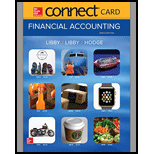
Connect Access Card for Financial Accounting
9th Edition
ISBN: 9781259738678
Author: Robert Libby, Patricia Libby, Frank Hodge Ch
Publisher: McGraw-Hill Education
expand_more
expand_more
format_list_bulleted
Question
Chapter 10, Problem 10.4CP
1.
To determine
Explain the reason why an investor buy a bond with a zero coupon rate.
2.
To determine
Calculate the amount that Company G received when it issued the bonds with a face value of €500 million.
3.
To determine
Calculate the amount that Company G received if the market interest rate is 3% and maturity period is 10 years.
Expert Solution & Answer
Want to see the full answer?
Check out a sample textbook solution
Students have asked these similar questions
??!
Kindly help me with this General accounting questions not use chart gpt please fast given solution
General accounting question
Chapter 10 Solutions
Connect Access Card for Financial Accounting
Ch. 10 - From the perspective of the issuer, what are some...Ch. 10 - What are the primary characteristics of a bond?...Ch. 10 - Prob. 3QCh. 10 - Differentiate between a bond indenture and a bond...Ch. 10 - Prob. 5QCh. 10 - Prob. 6QCh. 10 - Prob. 7QCh. 10 - Prob. 8QCh. 10 - What is the book value of a bond?Ch. 10 - Prob. 10Q
Ch. 10 - Prob. 11QCh. 10 - Prob. 12QCh. 10 - Prob. 1MCQCh. 10 - Prob. 2MCQCh. 10 - Prob. 3MCQCh. 10 - Prob. 4MCQCh. 10 - Prob. 5MCQCh. 10 - Prob. 6MCQCh. 10 - Prob. 7MCQCh. 10 - Prob. 8MCQCh. 10 - Prob. 9MCQCh. 10 - Prob. 10MCQCh. 10 - Prob. 10.1MECh. 10 - Computing the Price of a Bond Issued at Par LO10-2...Ch. 10 - Understanding Financial Ratios 0-3, 10-6 The...Ch. 10 - Computing the Times Interest Earned Ratio LO10-3...Ch. 10 - Computing the Price of a Bond Issued at a Discount...Ch. 10 - Recording the Issuance and Interest Payments of a...Ch. 10 - Prob. 10.7MECh. 10 - Prob. 10.8MECh. 10 - Prob. 10.9MECh. 10 - Prob. 10.10MECh. 10 - Prob. 10.11MECh. 10 - Prob. 10.12MECh. 10 - Prob. 10.13MECh. 10 - Prob. 10.14MECh. 10 - Prob. 10.1ECh. 10 - Prob. 10.2ECh. 10 - Prob. 10.3ECh. 10 - Computing Issue Prices of Bonds Sold at Par, at a...Ch. 10 - Prob. 10.5ECh. 10 - Prob. 10.6ECh. 10 - Prob. 10.7ECh. 10 - Prob. 10.8ECh. 10 - (Chapter Supplement) Recording and Reporting a...Ch. 10 - Prob. 10.10ECh. 10 - Prob. 10.11ECh. 10 - Explaining Why Debt Is Issued at a Price Other...Ch. 10 - Prob. 10.13ECh. 10 - Prob. 10.14ECh. 10 - Prob. 10.15ECh. 10 - Prob. 10.16ECh. 10 - Prob. 10.17ECh. 10 - Prob. 10.18ECh. 10 - Prob. 10.19ECh. 10 - Prob. 10.20ECh. 10 - Prob. 10.21ECh. 10 - Prob. 10.22ECh. 10 - Prob. 10.23ECh. 10 - Prob. 10.24ECh. 10 - Prob. 10.1PCh. 10 - Prob. 10.2PCh. 10 - Comparing Bonds Issued at Par, at a Discount, and...Ch. 10 - Prob. 10.4PCh. 10 - Prob. 10.5PCh. 10 - Recording and Reporting Bonds Issued at a Discount...Ch. 10 - Recording and Reporting a Bond Issued at a...Ch. 10 - Prob. 10.8PCh. 10 - Prob. 10.9PCh. 10 - Prob. 10.10PCh. 10 - Prob. 10.11PCh. 10 - Prob. 10.12PCh. 10 - Prob. 10.13PCh. 10 - Prob. 10.14PCh. 10 - Prob. 10.15PCh. 10 - Prob. 10.16PCh. 10 - Prob. 10.1APCh. 10 - Prob. 10.2APCh. 10 - Prob. 10.3APCh. 10 - Prob. 10.4APCh. 10 - Prob. 10.5APCh. 10 - Prob. 10.6APCh. 10 - Recording and Reporting a Bond Issued at a Premium...Ch. 10 - Prob. 10.8APCh. 10 - Prob. 10.1CONCh. 10 - Prob. 10.1CPCh. 10 - Prob. 10.2CPCh. 10 - Prob. 10.3CPCh. 10 - Prob. 10.4CPCh. 10 - Prob. 10.5CPCh. 10 - Evaluating an Ethical Dilemma LO 10-1 Assume that...
Knowledge Booster
Similar questions
- At the beginning of the year, Quantum Industries' liabilities equal $92,000. During the year, assets increase by $64,000, and at year-end, assets equal $320,000. Liabilities decrease by $15,000 during the year. What are the beginning and ending amounts of equity? Answerarrow_forwardGeneral accounting questionarrow_forwardPlease provide the solution to this financial accounting question with accurate financial calculations.arrow_forward
- Please show me the valid approach to solving this financial accounting problem with correct methods.arrow_forwardA new product, a smart coffee grinder, is being introduced at Kinetic Appliances. At a selling price of $95 per unit, management projects sales of 64,000 units. Launching the coffee grinder as a new product would require an investment of $750,000. The desired return on investment is 15%. What is the target cost per coffee grinder?arrow_forwardGood solution...???arrow_forward
- Cary Fabrication uses a normal cost system and had the following data available for 2022:arrow_forwardPlease help me solve this general accounting problem with the correct financial process.arrow_forwardAbbott Manufacturing produces a single product. Variable production costs are $18.2 per unit, and variable selling and administrative expenses are $4.5 per unit. Fixed manufacturing overhead totals $72,000, and fixed selling and administration expenses total $48,000. Assuming a beginning inventory of zero, production of 7,500 units, and sales of 5,800 units, the dollar value of the ending inventory under variable costing would be_.arrow_forward
arrow_back_ios
SEE MORE QUESTIONS
arrow_forward_ios
Recommended textbooks for you
 EBK CONTEMPORARY FINANCIAL MANAGEMENTFinanceISBN:9781337514835Author:MOYERPublisher:CENGAGE LEARNING - CONSIGNMENT
EBK CONTEMPORARY FINANCIAL MANAGEMENTFinanceISBN:9781337514835Author:MOYERPublisher:CENGAGE LEARNING - CONSIGNMENT

EBK CONTEMPORARY FINANCIAL MANAGEMENT
Finance
ISBN:9781337514835
Author:MOYER
Publisher:CENGAGE LEARNING - CONSIGNMENT